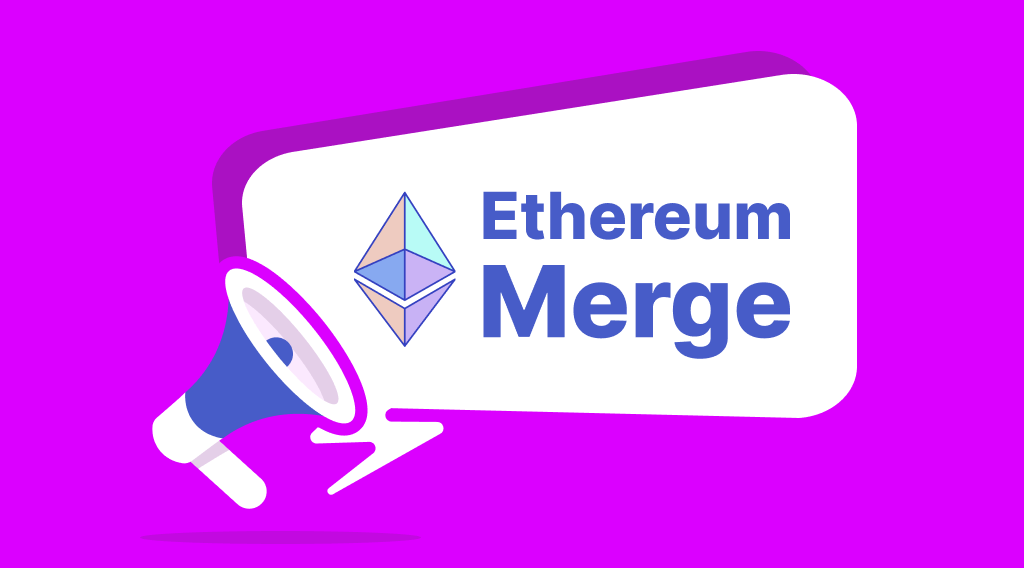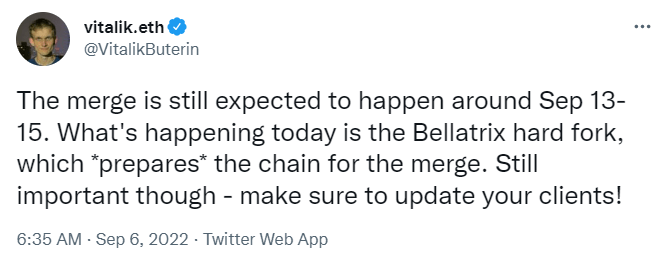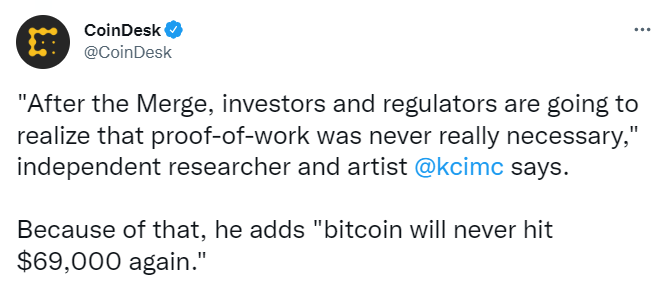Ethereum Merge Date – Ethereum 2.0 Goes Live

The Ethereum mainnet has been expected to undergo a consensus mechanism upgrade for some time now. In essence, it’s a hard fork – or a separation process – that converts Ethereum (ETH) from a Proof-of-Work (PoW) base to a Proof-of-Stake (PoS) basis and it’s known as Ethereum 2 or Ethereum 2.0. The long-awaited change of mechanisms is also often referred to as The Merge. The Ethereum Merge is part of a series of major blockchain upgrades, which also include The Surge, The Verge, The Purge, and The Splurge. Sharding is definitely in the works and scheduled to take place sometime in 2023 after The Merge.
All these upgrades are aimed at making Ethereum more scalable and energy efficient. Before the Ethereum blockchain was about to enter this turbulent phase, we covered the transition from PoW to PoS in this article.

Article contents
What Is the Ethereum Merge and Why Is It Upgrading?
Blockchains are usually designed to be decentralized, and that’s why they are permissionless, trustless, and more secure by being resistant to single points of failure. As blockchains grow more popular, platforms must ensure that they can match the global needs for transaction processing speeds, also known as scalability demands. If these needs are not met, it might result in network congestion, when blockchain capacity is overwhelmed by the number of pending transactions. In addition, users will have to pay higher gas fees.
However, achieving security and scalability is not something that could be easily done if blockchains are to stay decentralized. The Ethereum network as it is now can’t satisfy the criteria for scalability due to its consensus mechanism called the Proof-of-Work. A Proof-of-Work blockchain tends to be harder to scale due to a number of reasons. Firstly, the number of transactions that a block can validate in each block is limited. Secondly, blocks have to be mined at a constant rate.
In order to overcome the limitations imposed by the consensus mechanism, the Ethereum team proposed a set of upgrades known as Ethereum 2.0 or ETH 2.0. In addition to this, the rate of energy consumption is a major criticism of the Proof-of-Work consensus, which will remain the basis of Bitcoin mining after Ethereum switches to the new paradigm. You can read more about the reasons for ETH upgrade in this article.
Ethereum 2.0 Release Date
The Merge will combine the Ethereum mainnet with the Proof-of-Stake Beacon Chain and was originally scheduled to happen between September 10th and September 20th, 2022. Ethereum 2.0 has been introduced gradually through several stages, and the process started in December, 2020.
The Beacon Chain Upgrade
The first step towards Ethereum 2.0 was the so-called Beacon Chain, which also marked Phase 0 and was launched on December 1st, 2020. Beacon Chain is the coordination mechanism of the new network, responsible for creating new blocks, making sure those new blocks are valid, and rewarding validators with ETH for keeping the network secure. Beacon Chain upgrade introduced the mechanism, laid the foundation for future changes and enabled users to stake their Ethereum and become validators.
The Berlin Upgrade
In April, the Ethereum blockchain experienced the Berlin update that included four proposals (EIP) to improve the blockchain as part of its upgrade to version 2.0. The upgrade followed the Istanbul and Muir Glacier upgrades and was scheduled to go live on the Ethereum mainnet at block 12 244 000.
The Gary Glacier Upgrade
In addition, according to the official Ethereum website, the Gray Glacier network upgrade released on June 29, 2022, changed the parameters of the Ice Age/Difficulty Bomb, pushing it back by 700,000 blocks, or roughly 100 days. This has also been done in the Byzantium, Constantinople, Muir Glacier, London and Arrow Glacier network upgrades, and Gray Glacier was not deployed on any testnet.
The Bellatrix Upgrade
Finally, the last update of the blockchain is called Bellatrix. The Bellatrix update is the last change before The Merge. It ensures that the process goes smoothly and was activated on September 7th. Bellatrix was successfully codified into the codebase at epoch 144,896 on the Beacon chain. Bellatrix is the update to the Ethereum Virtual Machine, the part of the network that hosts the decentralized apps. The update should also provide improved security, better performance, and higher scalability to the network, as per Ethereum Foundation.
During the introduction of the update, the blockchain experienced some problems. At least 5% of the validators dropped offline during the hard fork, which contributed to the 9% missed block rate. Before the update, this rate had been around 0.5%. However, a number of developers have claimed that this might have been due to validators missing the software upgrade.
This upgrade consolidates the Proof-of-Stake chain with the current execution layer and is the last before the Paris Upgrade, which will occur after the Merge. The Paris upgrade will put a stop to Ethereum blockchain mining and signal the switch from a Proof-of-Work validation system to a Proof-of-Stake validation mechanism.
Since Bellatrix was added, the price of ETH has jumped 5.7% higher against the U.S. dollar and the crypto asset has been nearing the $1,700 per unit range.
The Merge and ETH 2.0 Merge Date
According to Vitalik Buterin’s tweet, The Merge itself is estimated to take place on September 13-15, 2022.

After this stage, it could be said that Ethereum 2.0 would be fully launched.
What Should Users Do?
Ethereum’s transactional history will be merged with the Beacon Chain, but the blockchain’s native cryptocurrency that’s attached to it will remain as is. ETH funds will remain accessible after The Merge, and ETH token users are not required to take any action in preparation for the upgrade.
The New Upgraded Ethereum: Features
The updated Ethereum blockchain is expected to improve and become:
- Secure: Ethereum needs to be more secure. As the adoption of Ethereum grows, the protocol needs to become more secure against all forms of attack.
- Sustainable: Ethereum needs to be better for the environment. The technology today requires too much computing power and energy.
- Scalable: Ethereum needs to support 1000s of transactions per second, to make applications faster and cheaper to use.
However, it should be noted that the current blockchain model has a token issuance system that distributes roughly 13,000 ETH per day in mining and staking rewards. Although the upgrade will alleviate energy concerns, after The Merge is implemented, there will no longer be mining rewards. The new ETH issuance will be reduced to approximately 1,600 ETH per day in staking rewards.
The Merge: Changes for the Crypto Field
After completing all listed upgrades, Ethereum will likely be able to take on more transaction loads without compromising security or decentralization. Among all the speculation some crypto enthusiasts claim that The Merge will drastically change the way developers are looking at Bitcoin and its alternatives.

For instance, Kyle McDonald, a crypto expert, claims that Bitcoin will never go as high as $69,000, because ‘investors and regulators are going to realize that PoW was never really necessary.’ Vitalik Buterin also expressed his concerns about Bitcoin’s Proof-of-Work issuance model. His concerns, however, relate not only to the energy consumption of the present but how the constant issuance of a Proof-of-Work token will affect future validation.
The Merge will essentially mark the end of the era of mining Ethereum like before. On one hand, this will increase blockchain security of such blockchains as Ethereum Classic (ETC) and Ravencoin (RVN). But on the other hand, it will also increase the complexity of mining these cryptocurrencies. On September, 5th, the hash rate of Ethereum Classic reached the highest in history as a lot of miners switched to mining this altcoin instead of Ethereum.
Nonetheless, many crypto enthusiasts believe that The Merge is more hyped than it really should be. And taking into consideration that Ethereum had fallen much harder than Bitcoin had since the end of last year, the whole ‘merge’-thing is just catching up with the first cryptocurrency. One thing is certain, though: it’s quite possible that the Ethereum token’s price will change following The Merge. If you want to participate in the future fate of the ETH project, you can buy Ethereum using StealthEX crypto exchange.
How to Buy ETH at StealthEX?
Buying Ethereum on StealthEX is simple. You can do this privately and without the need to sign up for the service. Our crypto collection has more than 450 different coins and you can do wallet-to-wallet transfers instantly and problem-free.
Just go to StealthEX and follow these easy steps:
- Choose the pair and the amount for your exchange. For example, BTC to ETH.
- Press the “Start exchange” button.
- Provide the recipient address to which the coins will be transferred.
- Move your cryptocurrency for the exchange.
- Receive your ETH coins!
Follow us on Medium, Twitter, Telegram, YouTube, and Reddit to stay updated about the latest news on StealthEX.io and the rest of the crypto world.
Don’t forget to do your own research before buying any crypto. The views and opinions expressed in this article are solely those of the author.
crypto world ETH 2.0 Ethereum 2.0 Ethereum 2.0 release date Ethereum MergeRecent Articles on Cryptocurrency
 OFFICIAL TRUMP Coin Price Prediction: How High Will TRUMP Crypto Go?
OFFICIAL TRUMP Coin Price Prediction: How High Will TRUMP Crypto Go?  FUNToken Price Prediction: Can FUN Coin Reach $1?
FUNToken Price Prediction: Can FUN Coin Reach $1? 
